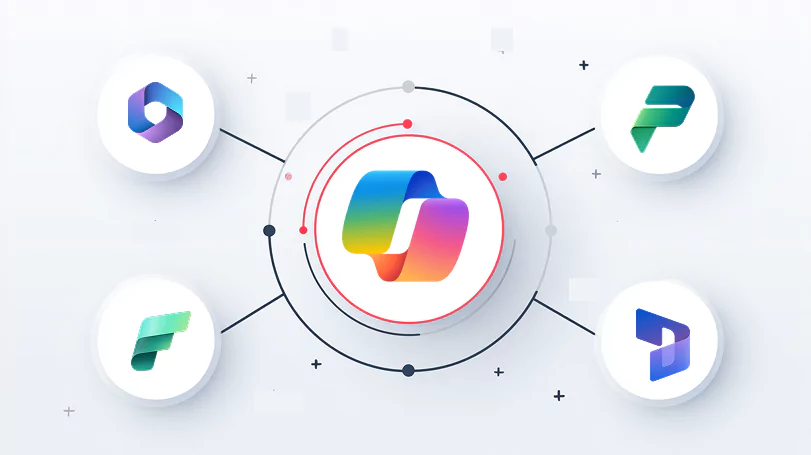What leadership teams need to know before rolling out Copilot

Artificial intelligence has moved from theory to practical reality inside the workplace. Leaders are no longer asking if they should adopt tools like Microsoft Copilot but how quickly and on what terms. The challenge is clear: seize the opportunity to improve productivity, collaboration, and decision-making without losing control of governance or strategy. Getting this balance right is not just a technology decision - it is a leadership responsibility.
At ARP Ideas, we work with organisations that are taking their first steps with Copilot and with those scaling across business units. This article distils what leadership teams need to know before rolling out Copilot in a way that maximises value and minimises risk.
Understanding what Copilot actually is
Copilot is not a single app you install and switch on. It is an AI-powered assistant woven directly into Microsoft 365, Dynamics 365, Power Platform, and other Microsoft environments. Think of it as a contextual companion that understands your data and surfaces relevant insights when you need them.
This distinction matters. Leaders sometimes expect Copilot to act like a human replacement. In reality, it augments existing workflows rather than replacing jobs. For example, in Outlook, it can help draft responses, in Dynamics 365 Sales, it can highlight promising leads, and in Teams, it can summarise meetings. It provides speed and support, not independent decision-making.
Common misconceptions include:
-
Believing Copilot will run entirely without human validation.
-
Assuming it can understand context outside your organisation’s data.
-
Expecting immediate transformation without proper adoption planning.
By setting realistic expectations early, leaders can avoid disillusionment and ensure teams see Copilot as a partner rather than a threat.
Why timing and readiness matter
Rolling out Copilot is as much about organisational maturity as it is about licensing or configuration. Businesses that jump in without preparation risk poor adoption and even compliance issues.
Readiness checks worth considering
-
Infrastructure: Copilot relies on Microsoft Graph and Azure OpenAI. Legacy systems may need modernisation or integration work.
-
Data maturity: Poorly governed or siloed data leads to inaccurate outputs. Leaders should prioritise data quality initiatives before rollout.
-
Culture: A workforce comfortable with digital change is more likely to embrace AI tools. Training and communication are key.
According to Microsoft’s 2024 Work Trend Index, 75 % of knowledge workers now use generative AI at work, and 78 % of those using AI are bringing their own AI tools to work to cope with workload pressures. This appetite highlights the opportunity, but it also underlines the risk of moving too quickly. Without adequate preparation, leaders may introduce Copilot into an environment not ready to take advantage of it.
The business value leaders should expect
When rolled out thoughtfully, Copilot delivers tangible results. The most important step for leadership is to translate features into measurable outcomes.
Measurable benefits include:
-
Productivity gains: Microsoft research shows early Copilot users reported a 29% faster task completion rate when summarising documents and emails.
-
Smarter decision-making: Instant access to insights from large datasets within Microsoft Fabric or Power BI.
-
Cross-team collaboration: Sales, operations, and IT teams can access the same AI-driven summaries, ensuring alignment.
-
Employee empowerment: By reducing repetitive tasks, employees can focus on higher-value activities.
From ARP Ideas’ experience, organisations that link Copilot pilots to specific KPIs - such as reducing proposal turnaround time by 20% - see faster buy-in from both staff and stakeholders. Leaders should focus on framing AI as a strategic tool for efficiency and innovation.
A scenario: Copilot in action
Consider a mid-size B2B services company using Dynamics 365 Sales. The leadership team launches a Copilot pilot programme to support account managers.
How it plays out:
-
Copilot analyses CRM data and highlights leads with the highest likelihood of conversion.
-
It drafts personalised outreach emails, which managers quickly review and adapt.
-
During pipeline meetings, Copilot provides summary views, helping managers prioritise their week.
-
Insights flow into Power BI dashboards for leadership, giving a live view of performance improvements.
The result: sales cycles shorten, admin overhead reduces, and managers focus on building relationships rather than filling spreadsheets. ARP Ideas has observed similar scenarios where integrating Copilot into Dynamics 365 results in a measurable increase in pipeline velocity within months.
Challenges and myths that leadership must address
No technology adoption is without hurdles. Copilot is powerful, but it requires guardrails and realistic expectations.
| Myth | Reality |
|---|---|
| Copilot always produces accurate answers | Copilot generates outputs based on your data, but human validation is essential. |
| Copilot is a replacement for employees | It is designed to assist, not replace. It improves capacity, but leadership and judgement remain human. |
| Security is automatically covered | Microsoft provides enterprise-grade security, but leaders must configure governance and compliance policies. |
| The ROI is instant | Value builds over time, often starting with pilots and scaling gradually. |
Leaders must actively address employee concerns around job security. Transparent communication about Copilot as a support tool helps reduce resistance. Governance frameworks covering data handling, permissions, and compliance are also critical. This is where ARP Ideas partners with organisations to establish safe, scalable adoption strategies.
Building a roadmap for Copilot adoption
Successful AI adoption rarely happens in one leap. It requires a clear, phased approach that combines technology, culture, and governance.
Steps to consider
-
Define success metrics early: Link Copilot projects to measurable outcomes like reduced time-to-market or customer satisfaction improvements.
-
Start small: Pilot Copilot in one department, collect feedback, and adjust before scaling.
-
Upskill your people: Provide training on both technical use and AI literacy. Confidence accelerates adoption.
-
Leverage expertise: ARP Ideas helps organisations integrate Copilot with Dynamics 365, Power Platform, and Microsoft Fabric, ensuring alignment with business goals.
A roadmap should blend technical planning with cultural preparation. Leaders who focus on both dimensions create the strongest foundation for success.
Looking ahead: Copilot and the future of work
Copilot is not a passing trend. It represents a broader shift from isolated tools to connected ecosystems where AI acts as a common layer across applications. For leaders, the challenge will be to continually align technology use with strategic goals.

Microsoft continues to expand the scope of Copilot, from CRM and ERP to developer tools and analytics. The organisations that thrive will be those that treat AI adoption as a continuous journey rather than a one-off project. With partners like ARP Ideas, leadership teams can ensure their businesses stay ahead of the curve in this evolving landscape.
Key Takeaways
-
Copilot is an integrated assistant that augments workflows, not a replacement for staff.
-
Readiness, in terms of infrastructure, data, and culture, is essential before rollout.
-
The value of Copilot lies in measurable business outcomes, including productivity and collaboration.
-
Pilot projects linked to KPIs drive adoption and prove ROI.
-
Leadership must strike a balance between opportunity and governance, as well as maintain transparent communication.
FAQ
Is Copilot secure for enterprise data?
Yes. It operates within Microsoft’s enterprise-grade security framework. However, organisations must still configure governance and compliance to match their needs.
Will Copilot replace jobs?
No. It reduces repetitive tasks but still requires human judgment and oversight. Leaders should communicate this clearly to their teams.
How quickly can we expect ROI?
Most organisations see early benefits within a few months when starting with targeted pilots. Full ROI depends on scale and integration.
Do we need Dynamics 365 or Power Platform to benefit?
Not necessarily. Copilot is embedded in Microsoft 365, too, so any organisation can start small and expand into specialised areas later.
Why work with ARP Ideas?
We combine technical expertise with a deep understanding of business processes. Our team has helped mid-size and enterprise organisations adopt Microsoft AI solutions responsibly and strategically.
Conclusion
Rolling out Microsoft Copilot is more than a technical implementation. It is a leadership decision that touches on strategy, culture, and governance. Success comes from preparation - ensuring data quality, building readiness, and setting realistic expectations. When done well, Copilot unlocks measurable business value: greater productivity, faster decision-making, and stronger collaboration.
The organisations that benefit most are those that see Copilot as part of a broader digital transformation journey, not a shortcut. By combining the right tools with a thoughtful roadmap, leadership teams can create a foundation for sustainable innovation.
Ready to explore what Copilot can do for your organisation?
At ARP Ideas, we help businesses design and deliver Copilot rollouts that align with their goals, strengthen governance, and empower teams. Whether you are planning a pilot or scaling across departments, our expertise ensures adoption is secure, strategic, and impactful.
Get in touch with ARP Ideas today to start shaping your Copilot journey.

